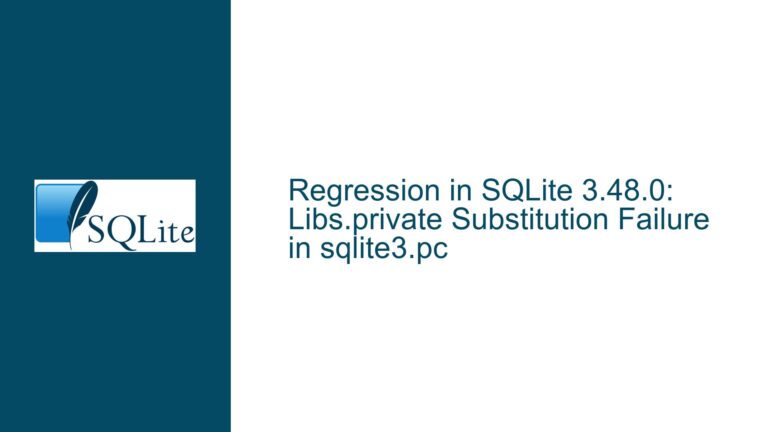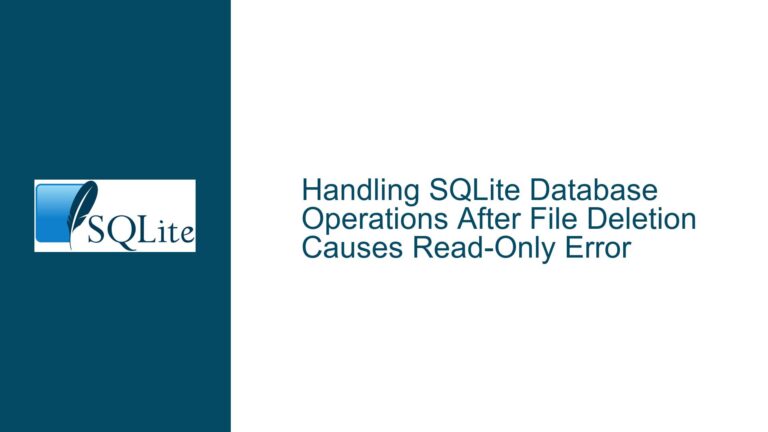SQLite Implicit Transactions and Autocommit Behavior
Implicit Transactions and Autocommit Mode in SQLite
SQLite is a lightweight, serverless database engine that is widely used due to its simplicity and efficiency. One of the key features of SQLite is its transaction management, which includes both explicit and implicit transactions. Understanding how these transactions work, particularly in the context of autocommit mode, is crucial for developers who want to ensure data integrity and optimize performance.
Implicit Transactions and Autocommit Mode
In SQLite, every SQL statement is executed within a transaction. When a statement is executed outside of an explicit transaction (i.e., without a BEGIN statement), SQLite automatically starts an implicit transaction for that statement. This implicit transaction is committed automatically when the statement completes. This behavior is known as autocommit mode.
Autocommit mode is the default mode in SQLite. When a connection is opened, it starts in autocommit mode, meaning that each statement is treated as a separate transaction. The sqlite3_get_autocommit() function can be used to determine whether a connection is currently in autocommit mode. If the function returns true, the connection is in autocommit mode, and each statement will be automatically committed upon completion.
However, the documentation on implicit transactions and autocommit mode can be somewhat unclear. The section on implicit transactions does not explicitly mention autocommit mode, and the section on sqlite3_get_autocommit() does not discuss implicit transactions. This can lead to confusion, particularly when dealing with multiple statements and open cursors.
Implicit Transactions with Multiple Statements
A common point of confusion arises when multiple statements are executed on the same connection, particularly when one of those statements is a SELECT statement that returns multiple rows. According to the documentation, an implicit transaction is committed automatically when the last active statement finishes. A statement is considered finished when its last cursor closes.
However, this behavior may not always align with expectations. For example, consider a scenario where a SELECT statement is executed, and rows are retrieved incrementally. While the SELECT statement is still active (i.e., the cursor is still open), an INSERT statement is executed on the same connection. According to the documentation, the INSERT statement should be part of the same implicit transaction as the SELECT statement, and the transaction should not be committed until the SELECT statement is fully exhausted.
In practice, however, the INSERT statement may be committed immediately, even while the SELECT statement is still active. This behavior can be observed by running a SELECT COUNT(*) statement on a different connection, which will show that the INSERT statement has been committed before the SELECT statement has finished. This discrepancy between the documented behavior and the actual behavior can lead to confusion, particularly when dealing with concurrent connections.
Implicit Transactions and Explicit Transactions
Another area of confusion is the interaction between implicit transactions and explicit transactions. An explicit transaction is started with a BEGIN statement and ended with a COMMIT or ROLLBACK statement. When an explicit transaction is active, the autocommit mode is effectively disabled, and the transaction must be explicitly committed or rolled back.
However, the behavior of explicit transactions can be influenced by the presence of open cursors from implicit transactions. According to the documentation, an implicit transaction will not be committed if a cursor is still open from a statement. This raises the question of whether an explicit COMMIT statement will actually commit the changes to disk if a cursor is still open from a previous statement.
In practice, an explicit COMMIT statement will commit the changes to disk, even if a cursor is still open from a previous statement. However, the read lock held by the open cursor may prevent other connections from acquiring a write lock until the cursor is closed. This behavior can be observed by running a SELECT statement, starting an explicit transaction, executing an INSERT statement, and then committing the transaction while the SELECT statement is still active. The INSERT statement will be committed, but the read lock held by the SELECT statement will prevent other connections from acquiring a write lock until the SELECT statement is fully exhausted.
Locking Mechanisms and Transaction Control in SQLite
Lock Acquisition and Release
SQLite uses a locking mechanism to control access to the database. When a statement is executed, it must acquire the necessary locks for the duration of its execution. The type of lock required depends on the type of statement being executed. For example, a SELECT statement requires a read lock, while an INSERT statement requires a write lock.
When a statement completes, the locks that were acquired by that statement are released, unless the connection is in an explicit transaction. In the case of an explicit transaction, the locks are held until the transaction is committed or rolled back. This behavior ensures that changes made within the transaction are not visible to other connections until the transaction is committed.
The BEGIN statement can be used to start an explicit transaction and control the locking behavior. The BEGIN IMMEDIATE statement acquires a write lock immediately, while the BEGIN EXCLUSIVE statement acquires an exclusive lock. These locks prevent other connections from acquiring conflicting locks until the transaction is committed or rolled back.
Autocommit and Lock Release
The autocommit mode in SQLite is closely related to the locking mechanism. When a connection is in autocommit mode, the locks acquired by a statement are automatically released when the statement completes. This behavior ensures that changes made by the statement are immediately visible to other connections.
However, when a connection is in an explicit transaction, the locks are held until the transaction is committed or rolled back. This behavior can lead to contention between connections, particularly when one connection holds a read lock while another connection attempts to acquire a write lock.
The COMMIT statement in SQLite does not immediately commit the changes to disk. Instead, it turns autocommit mode back on and releases the locks that are no longer required. If a cursor is still open from a previous statement, the read lock held by that cursor will not be released until the cursor is closed. This behavior ensures that the changes made within the transaction are not visible to other connections until all relevant locks are released.
Practical Implications and Best Practices
Managing Cursors and Transactions
One of the key takeaways from the behavior of implicit and explicit transactions in SQLite is the importance of managing cursors and transactions carefully. When a SELECT statement is executed, the cursor remains open until all rows have been retrieved or the cursor is explicitly closed. If a cursor is left open, it can prevent other connections from acquiring a write lock, even after an explicit COMMIT statement has been executed.
To avoid this issue, developers should ensure that cursors are closed as soon as they are no longer needed. In the Python sqlite3 module, this can be done by calling the .close() method on the Cursor object. Failing to close cursors can lead to contention and reduced performance, particularly in multi-threaded or multi-process applications.
Using Explicit Transactions for Batch Operations
Another best practice is to use explicit transactions for batch operations, particularly when performing multiple INSERT, UPDATE, or DELETE statements. By wrapping these statements in an explicit transaction, developers can ensure that the changes are committed atomically and that the locks are held for the minimum amount of time.
For example, consider a scenario where multiple INSERT statements are executed to populate a table. If these statements are executed in autocommit mode, each statement will be treated as a separate transaction, and the changes will be committed immediately. This can lead to reduced performance, as each statement will acquire and release a write lock.
By wrapping the INSERT statements in an explicit transaction, the write lock is acquired once and held until the transaction is committed. This reduces the overhead associated with acquiring and releasing locks and can significantly improve performance.
Avoiding Long-Running Transactions
Long-running transactions can lead to contention and reduced performance, particularly in multi-threaded or multi-process applications. When a transaction is held open for an extended period, it can prevent other connections from acquiring the necessary locks to perform their operations.
To avoid this issue, developers should aim to keep transactions as short as possible. This can be achieved by breaking large transactions into smaller, more manageable chunks and committing each chunk separately. Additionally, developers should avoid performing long-running operations, such as network requests or complex calculations, within a transaction.
Monitoring and Debugging Lock Contention
Finally, developers should be aware of the potential for lock contention in SQLite and take steps to monitor and debug any issues that arise. The sqlite3 module provides several tools for monitoring locks, including the sqlite3_status() function, which can be used to retrieve information about the current state of the database connection.
Additionally, developers can use the PRAGMA locking_mode statement to control the locking behavior of the database. For example, setting the locking mode to EXCLUSIVE can prevent other connections from accessing the database while a transaction is in progress. However, this should be used with caution, as it can lead to reduced concurrency and increased contention.
Conclusion
Understanding the behavior of implicit and explicit transactions in SQLite is crucial for developers who want to ensure data integrity and optimize performance. By carefully managing cursors, using explicit transactions for batch operations, avoiding long-running transactions, and monitoring lock contention, developers can avoid common pitfalls and ensure that their applications run smoothly.
While the documentation on implicit transactions and autocommit mode can be somewhat unclear, the behavior of SQLite is consistent and predictable once understood. By following the best practices outlined in this guide, developers can take full advantage of SQLite’s transaction management capabilities and build robust, high-performance applications.






